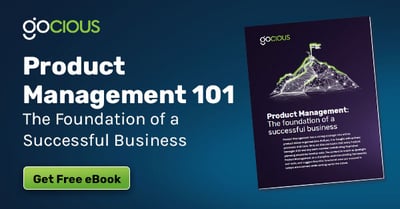 If you are an ambitious professional who desires a meaningful career in product management, there will be plenty of professional development opportunities to enhance your skill set as you gain more experience in your field. One of the most valuable strengths you can acquire is the ability to give an impactful presentation. Whether you are showcasing a new product idea, introducing a new product marketing strategy, or giving a post-launch debrief to your chief product officer, being able to share your information confidently and effectively will go a long way.
If you are an ambitious professional who desires a meaningful career in product management, there will be plenty of professional development opportunities to enhance your skill set as you gain more experience in your field. One of the most valuable strengths you can acquire is the ability to give an impactful presentation. Whether you are showcasing a new product idea, introducing a new product marketing strategy, or giving a post-launch debrief to your chief product officer, being able to share your information confidently and effectively will go a long way.
Why Impactful Presentations Matter
Typically product managers have a hand in every aspect of a product strategy, overseeing the product, marketing, and engineering teams to make sure everyone’s roles and responsibilities align with the product vision. Because product managers are responsible for making sure every product meets the market smoothly, they have a well-rounded perspective of the business and can present learning opportunities to their teams after every launch. When you jump into your product management role, you can expect to do several presentations for your peers, so let’s talk about how to make sure your presentations leave a meaningful impression on their audiences.
How to Make Your Presentations More Impactful
 Consider the goal of your presentation. Are you sharing data-backed ideas on how to maximize the user experience? Are you communicating product roadmaps to improve day-to-day operations? Or maybe you are running through common pain points with suggestions on how to improve the product planning cycles. No matter what your presentation topic is, your main objective should be to communicate clearly to your audience. Collaborating with your peers and presenting new ideas is highly impactful for your organization’s bottom line.
Consider the goal of your presentation. Are you sharing data-backed ideas on how to maximize the user experience? Are you communicating product roadmaps to improve day-to-day operations? Or maybe you are running through common pain points with suggestions on how to improve the product planning cycles. No matter what your presentation topic is, your main objective should be to communicate clearly to your audience. Collaborating with your peers and presenting new ideas is highly impactful for your organization’s bottom line.
Let’s get into five ways you can make your next presentation impactful and engaging for any audience.
1. Know Your Audience
First things first, it is crucial to cater to your presentation audience. You might be presenting a new product line to stakeholders, which means your content, data, and visuals must grab their attention to pique their interest in your product. Maybe you are pitching new tools to streamline internal processes, including product roadmapping software, which requires an understanding of each team’s role in the production process. No matter who you are presenting to, consider keeping these impactful questions in mind:
- What do you want your audience to remember most?
- How do you want your audience to feel afterward?
- Where do you want your audience to go from here–what are some actionable items for them?
Once you understand who you are presenting to and what you would like the key takeaways to be, you may feel more confident in the content of your presentation. Just remember to also use language that your audience will understand so no one gets lost in any industry jargon along the way.
2. Make Timely Presentations
 When reporting to and keeping executives informed, it’s essential to schedule regular meetings and to present relevant, timely information. Your executives want to know certain details about the progress and performance of your products. Most product management tools cater to staff-level information and inter-departmental reporting. In these cases slides can be your friend. But as the product and business case become complex, you may want to choose innovative roadmapping tools that provide clear visuals and customizable metric views to provide your superiors with up-to-date information. As the product manager, you clearly want to keep reports and presentations easy to communicate with the latest information.
When reporting to and keeping executives informed, it’s essential to schedule regular meetings and to present relevant, timely information. Your executives want to know certain details about the progress and performance of your products. Most product management tools cater to staff-level information and inter-departmental reporting. In these cases slides can be your friend. But as the product and business case become complex, you may want to choose innovative roadmapping tools that provide clear visuals and customizable metric views to provide your superiors with up-to-date information. As the product manager, you clearly want to keep reports and presentations easy to communicate with the latest information.
3. Reference Relevant Data and Graphs
In the product management industry, team members across departments rely on accurate research and data to inform their planning and execution processes. If you are presenting to external stakeholders, your ideas will only be as good as the numbers that back them up. A valuable rule of thumb is that you should be able to illustrate your presentation ideas with qualitative and/or quantitative data that your audience can reference to understand your position.
For product-specific presentations, you can pull product analytics directly from your product management tools and compare products side-by-side to give your audience relevant insight into why you may be pitching a new approach to a product marketing strategy or suggesting refinements to an existing product line for a better user experience.
4. Follow an Organized Structure
Are you someone who has a hard time staying on track when speaking in front of people? One way to keep yourself organized during a product pitch is to make sure it follows a structure from start to finish—similar to how you roadmap your products. Outline your ideas, data, and visuals in order of when you would like to speak about them and create a presentation based on your outline. Studies show that structuring your presentation like a story can help keep your audience engaged by following three sections:
Opening Section
Craft the beginning like a story that speaks to something your audience can relate to. Tell them how life is without your pitch and how it could be with your solution. This creates a bond and sets people up for what’s to come.
Middle Content
Develop the middle with relevant data and graphs to support the information you are sharing, reinforcing the benefit of what you are speaking about, whether it’s a new product line or a new product planning process.
Conclude Strongly
Make the ending powerful by including a call-to-action for your audience to consider that brings home the point of what you are presenting and how they can be part of the solution.
5. Use Eye-Catching Visuals
 Nothing captivates an audience like visuals that resonate with them on a meaningful level. Incorporating visual elements into your presentation will allow your audience to see what you are speaking about, painting a picture of your pitch powerfully. Images with bright colors, bold visuals, and engaging subjects can help bring your audience back into focus after listening to you speak and looking at numeric data on a screen.
Nothing captivates an audience like visuals that resonate with them on a meaningful level. Incorporating visual elements into your presentation will allow your audience to see what you are speaking about, painting a picture of your pitch powerfully. Images with bright colors, bold visuals, and engaging subjects can help bring your audience back into focus after listening to you speak and looking at numeric data on a screen.
Remember to select images that relate to your presentation topic. If you’re reporting on product performance, you’ll want to include easy-to-understand graphs and charts that display the metrics. If you’re presenting to your marketing or sales department, you may choose to use a photo that represents a metaphor for the topic or a comic that makes light of a pain point you are addressing. As long as the visuals tie into your presentation, convey the right message, and are suited to your audience, they will help you make an impact on your audience.
Feeling Nervous About Presentations? Go Practice!
An impactful presentation is not one that you should just do on a whim with little planning or preparation. You could be the most experienced and knowledgeable product manager on your team, but without running through your presentation more than once or twice, you run the risk of losing your place, forgetting your train of thought, or missing out on important highlights to cover. Rehearsing your presentation as many times as you need to feel comfortable with the subject matter will help you exude confidence in front of your peers and stakeholders on presentation day.
Gocious is a provider of Product Roadmap Management Software for companies that work at scale and need transparency and alignment across teams, specifically senior management. Find out more about the Gocious Product Roadmap Management Software by booking a demo with us. We’ll meet with you to show you around the program, get to know your needs, and discuss software features and how you can make them work for you and your company.



